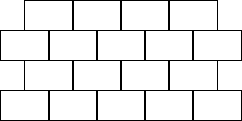A company has obtained permission to opencast mine within a square plot ![]() .[15] The angle of slip of the soil is such that it is not possible for the sides of the excavation to be steeper than
.[15] The angle of slip of the soil is such that it is not possible for the sides of the excavation to be steeper than ![]() . The company has obtained estimates for the value of the ore in various places at various depths. Bearing in mind the restrictions
imposed by the angle of slip, the company decides to consider the problem as one of the extracting of rectangular blocks.
Each block has horizontal dimensions
. The company has obtained estimates for the value of the ore in various places at various depths. Bearing in mind the restrictions
imposed by the angle of slip, the company decides to consider the problem as one of the extracting of rectangular blocks.
Each block has horizontal dimensions ![]() and a vertical dimension of 25 ft. If the blocks are chosen to lie above one another, as illustrated in vertical section
in Figure 14.1, then it is only possible to excavate blocks forming an upturned pyramid. (In a three-dimensional representation Figure 14.1 would show four blocks lying above each lower block.)
and a vertical dimension of 25 ft. If the blocks are chosen to lie above one another, as illustrated in vertical section
in Figure 14.1, then it is only possible to excavate blocks forming an upturned pyramid. (In a three-dimensional representation Figure 14.1 would show four blocks lying above each lower block.)
If the estimates of ore value are applied to give values (in percentage of pure metal) for each block in the maximum pyramid which can be extracted then the following values are obtained:
|
|
|
|
|
|||||||||||||||||||||||||||||
|
|
|
|
6.0 |
The cost of extraction increases with depth. At successive levels the cost of extracting a block is:
|
Level 1 |
£3000 |
|
Level 2 |
£6000 |
|
Level 3 |
£8000 |
|
Level 4 |
£10,000 |
The revenue obtained from a ‘100% value block’ would be £200,000. For each block here the revenue is proportional to ore value.
Build a model to help decide the best blocks to extract. The objective is to maximize ![]() .
.
